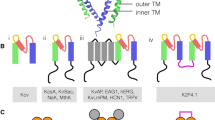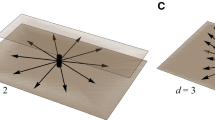Summary
Many ion channels that normally gate fully open or shut have recently been observed occasionally to display well-defined subconductance states with conductances much less than those of the fully open channel. One model of this behavior is a channel consisting of several parallel pores with a strong correlation between the flux in each pore such that, normally, they all conduct together but, under special circumstances, the pores may transfer to a state in which only some of them conduct. This paper introduces a general technique for modeling correlated pores, and explores in detail by computer simulation a particular model based upon electric interaction between the pores. Correlation is obtained when the transient electric field of ions passing through the pores acts upon a common set of ionizable residues of the channel protein, causing transient changes in their effective pK and hence in their charged state. The computed properties of such a correlated parallel pore channel with single occupation of each pore are derived and compared to those predicted for a single pore that can contain more than one ion at a time and also to those predicted for a model pore with fluctuating barriers. Experiments that could distinguish between the present and previous models are listed.
Similar content being viewed by others
References
Berry, R.M., Edmonds D.T. 1992. Carrier-like behaviour from a static but electrically responsive model pore. J. Theoret. Biol. 154:249–260
Besprozvanny, I.B., Benevolensky, D.S., Naumov, A.P., 1991. Potassium channels in aortic microsomes: conductance, selectivity, barium induced blockage and subconductance states. Biochim. Biophys. Acta 1064:75–80
Edmonds, D.T. 1989. A kinetic role for ionizable sites in membrane channel proteins. Eur. Biophys. J. 17:113–119
Edmonds, D.T., Berry, R.M. 1991. The proton ladder, a static mechanism for ion/proton coports and counterports. Eur. Biophys. J. 20:241–245
Fox, J.A. 1987. Ion channel subconductance states. J. Membrane Biol. 97:1–8
Hamill, O.P., Sakmann, B. 1981. Multiple conductance states of single acetylcholine receptor channels in embryonic muscle cells. Nature 294:462–464
Hille, B., Schwarz, W. 1978. Potassium channels as multi-ion single-file pores. J. Gen. Physiol. 72:409–442
Hodgkin, A.L., Keynes, R.D. 1955. The potassium permeability of a giant nerve fibre. J. Physiol. 128:61–68
Hunter, M., Giebisch, G. 1987. Multi-barreled K channels in renal tubules. Nature 327:522–524
Klein, J.K., Meijer, P.H.E. 1954. Principle of minimum entropy production. Phys. Rev. 96:250–255
Krouse, M.E., Schneider, G.T., Gage, P.W. 1986. A large anionselective channel has seven conductance levels. Nature 319:58–60
Kunze, D.L., Ritchie, A.K. 1990. The DHP-sensitive calcium channel in GH3 cells exhibits multiple conductance levels. Biophys. J. 57:396a
Kwok, W.M., Best, P.M. 1990. Ryanodine sensitivity and multiple conductance states of the Ca release channel from native SR membrane. Biophys. J. 57:168a
Läuger, P. 1985. Ion channels with conformational substates. Biophys. J. 47:581–591
Levitt, D.G. 1984. Kinetics of movement in narrow channels. Curr. Top. Membr. Transp. 21:181–197
Liu, Q.Y., Meissner, G., Lai, F.A., Rousseau, E., Jones, R.V. 1989. Multiple conductance states of the purified calcium release channel complex from skeletal sarcoplasmic reticulum. Biophys. J. 55:415–424
Lucchesi, K.J., Moczydlowski, E. 1991. On the interaction of bovine pancreatic trypsin inhibitor with maxi Ca2+-activated K+ channels. J. Gen Physiol. 97:1295–1319
Matsuda, H., Matsuura, H., Noma, A. 1989. Triple barrel structure of inwardly rectifying K+ channels revealed by Cs+ and Rb+ block in guinea-pig heart cells. J. Physiol. 413:139–157
Meves, H., Nagy, N. 1989. Multiple conductance states of the sodium channel and of other ion channels. Biochim. Biophys. Acta 988:99–105
Miller, C. 1982. Open-state structure of single chloride channels from Torpedo electroplax. Philos. Trans. R. Soc. B 299:401–411
Miller, C. 1991. Annus mirabilis of potassium channels. Science 252:1092–1096
Neumcke, B. Läuger, P. 1969. Nonlinear electrical effects in lipid bilayer membranes. Biophys. J. 9:1160–1170
Neumcke, B., Weik, R. 1988. Subconductance states of K channels in mouse muscle. Pfluegers Arch. 412 (Suppl. No. 1):R14
Parsegian, V.AQ. 1969. Energy of an ion crossing a low dielectric membrane: solutions of four relevant problems. Nature 221:844–846
Pottosin, I.I. 1992. Probing of pore in the Chara gymnophylla K+ channel by blocking cations and by streaming potential measurements. FEBS Lett. 298:253–256
Ravindran, A., Schild, L., Moczydlowski, E. 1991. Divalent cation selectivity for external block of voltage dependent Na+ channels prolonged by Batrachotoxin. J. Gen. Physiol. 97:89–143
Schlichter, L.C., Grygorczyk, R., Pahapill, P.A., Grygorczyk, C. 1990. A large multiple-conductance chloride channel in normal human T-lymphocytes. Pfluegers Arch. 416:413–421
Schreibmayer, W., Tritthart, H.A., Schindler, H. 1989. The cardiac sodium channel shows a regular substate pattern indicating synchronized activity of several ion pathways instead of one. Biochim. Biophys. Acta 986:172–186
Stockbridge, L.L., French, A.S., Man, S.F.P. 1991. Subconductance states in calcium-activated potassium channels from canine airway smooth muscle. Biochim. Biophys. Acta 1064:212–218
Vestergaard-Bogind, B., Stampe, P., Christopherson, P. 1985. Single-file diffusion through the Ca2+-activated K+ channel of human red cells. J. Membrane Biol. 88:67–75
Weik, R., Lonnendonker, U., Neumcke, B. 1989. Low-conductance states of K+ channels in adult mouse skeletal muscle. Biochim. Biophys. Acta 983:127–134
Author information
Authors and Affiliations
Additional information
R.M.B. is grateful to the S.E.R.C. for the award of a graduate studentship.
Rights and permissions
About this article
Cite this article
Berry, R.M., Edmonds, D.T. Correlated ion flux through parallel pores: Application to channel subconductance states. J. Membarin Biol. 133, 77–84 (1993). https://doi.org/10.1007/BF00231879
Received:
Revised:
Issue Date:
DOI: https://doi.org/10.1007/BF00231879




